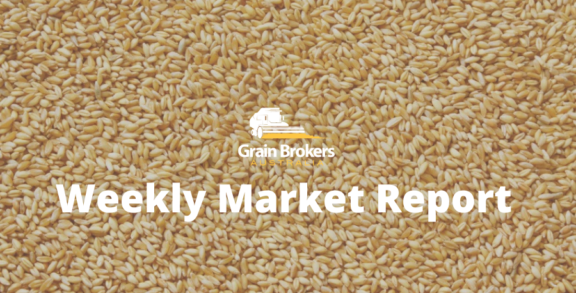
As this year’s winter and spring crop harvest finally draws to a close across England, initial production estimates suggest the country’s farmers have suffered their second worst harvest in recent years, after unseasonably wet, cold and windy weather restricted planting and hit production of the country’s key crops.
The United Kingdom experienced its second wettest August through February period since records began in 1837, according to the Agriculture and Horticulture Development Board (AHDB). This made it extremely difficult to conduct fieldwork in the autumn, dramatically reducing the winter crop seeding program. However, despite being planted later than normal, the spring crops did perform much better than their winter counterparts. Data from the UK Meteorological Office emphasises how the favourable weather early in the 2024 harvest gave way to unsettled weather and harvest delays toward the end of the campaign.
In England, wheat, barley, oats and oilseed rape are the principal grain crops grown each year, with the total area planted in the autumn of 2023 and the spring of 2024 coming in at 2.64 million hectares. This is 7.4 per cent lower than the 2.86Mha planted last season and 14.9 per cent below the ten-year average of 3.04Mha.
Breaking it down by commodity, the wheat, winter barley, and oilseed rape areas were down this season, but the oats and spring barley areas increased. Wheat commands the most significant proportion of the cropping area each year, with the final planted area of 1.4Mha representing 53 per cent of the total area planted to the four major crops against the ten-year average of 53.6 per cent. The area fell 11.2 percentage points from 1.58Mha in the previous season and was 16.2 per cent lower than the ten-year average of 1.63Mha.
A significant increase in the spring barley area, due to far more favourable planting conditions and ample fallow land, more than compensated for the lower winter barley area, with the total coming in 6.2 per cent higher season-on-season at 849,000 hectares. This was also 3.8 per cent higher than the average of the past ten seasons of 817,000ha.
The area planted to oats increased steadily from around 63,000ha in 1999 to peak at almost 170,000ha in 2020 before plateauing this decade. The area planted for the 2024/25 harvest was 148,000ha, 10.8 per cent higher than the previous year and 12.2 percentage points higher than the ten-year average of 130,000ha.
After peaking at 713,000ha in 2012, the oilseed rape area has been on a downward trajectory ever since, with the 245,000ha seeded last autumn 28.5 per cent lower than the previous season, 27.6 per cent lower than the five-year average, and 89 per cent lower than the ten-year average.
On the production front, initial estimates released by the United Kingdom’s Department for Environment, Food and Rural Affairs on October 10 pegged total wheat output at 9.99 million metric tonne, only the second sub-10MMT crop this century. The forecast puts the harvest 21.7 per cent lower than last season’s 12.76MMT haul and 33.9 per cent lower than the ten-year average of 13.38MMT. However, it is 13.2 per cent higher than the 8.67MMT disaster in 2020. An 11.8 per cent decrease in the average yield from 8.1 metric tonne per hectare to 7.1MT/ha was a significant contributor to the production decline.
Protein content of the wheat has generally been lower than usual across milling samples, averaging in the 11.5 to 12 per cent range. According to AHDB, blending higher protein imports with the lower protein UK samples will make the crop manageable. The test weight of the milling samples has been encouraging, averaging in the 76 to 78 kilograms per hectolitre range, while moisture content has been high in some cases, primarily in the later harvested crops. There are no major issues on a falling number basis, but ergot has reportedly been especially prevalent this season.
According to UK Flour Millers, wheat flour is an essential part of the UK diet, being an ingredient in about one-third of all grocery products. Wheat flour provides around 20 per cent of the energy and protein consumed in the UK and makes a significant contribution to vitamin and mineral intake. The association reported that about 12 million loaves of bread, two million pizzas and 10 million cakes and biscuits are made in the UK every day.
Total barley production is estimated at 4.95MMT, 2.7 per cent higher than the previous harvest of 4.82MT but 2.8 per cent lower than the ten-year average of 5.09MMT. The department is calling the winter barley crop down 26.5 per cent at 2.02MMT, but the spring barley crop was the biggest since 2020 at 2.93MMT, 41.1 per cent higher than the 2023 harvest. The average spring barley yield was 10.1 per cent higher than 2023 at 5.6MT/ha, while the average yield for the winter barley harvest was 11.7 per cent lower at 6.2MT/ha.
The quality of the winter malting barley is reportedly good, although some regions have had test weight and retention issues. According to AHDB’s latest harvest report, nitrogen levels have averaged around 1.5 per cent, with a range of 1.3 to 1.6 per cent. This is low for winter malting barley, where maltsters typically look for grain nitrogen of up to 1.75 per cent. It could prove a challenge for exports, with continental maltsters generally requiring a higher nitrogen level of up to 1.85 per cent. The spring malting barley samples are reported to be suffering a similar predicament.
The initial oat production outlook has this year’s crop pencilled in at 773,000 metric tonne 20.2 per cent higher than 2023/24, but only 8.7 per cent higher than the average for the ten years from 2014 to 2023. The average yield came in at 5.2MT/ha, higher than last year’s average of 4.8MT/ha but lower than the ten-year average of 5.5MT/ha.
While the quality of England’s oilseed rape harvest has been good this season, total production plummeted 32.9 per cent. The initial output estimated is 687,000 metric tonne, compared to 1.02MMT last year and the ten-year average of 1.64MMT. The fall was primarily driven by the aforementioned decrease in planted area, but the average yield across the country also fell 7.9 per cent from 3MT/ha to 2.8MT/ha. The average oil content is reported to be more than 45 per cent, with very few samples under 44 per cent. While one of the drivers of lower yield has reportedly been smaller seed size, it does not appear to have adversely impacted oil content.
As the 2024 harvest wound down, farmer focus quickly turned to the next winter crop seeding program. This not only means taking advantage of better sowing conditions by planting early but also weighing up the production risks posed by barley yellow dwarf virus, take-all, grass weeds and increased disease pressure when finalising crop rotation options. Early reports suggest that plantings have returned to the more normal levels recorded in the autumn of 2022, a direct consequence of the favourable seeding conditions through September and early October.
Call your local Grain Brokers Australia representative on 1300 946 544 to discuss your grain marketing needs.
Written by Peter McMeekin.





